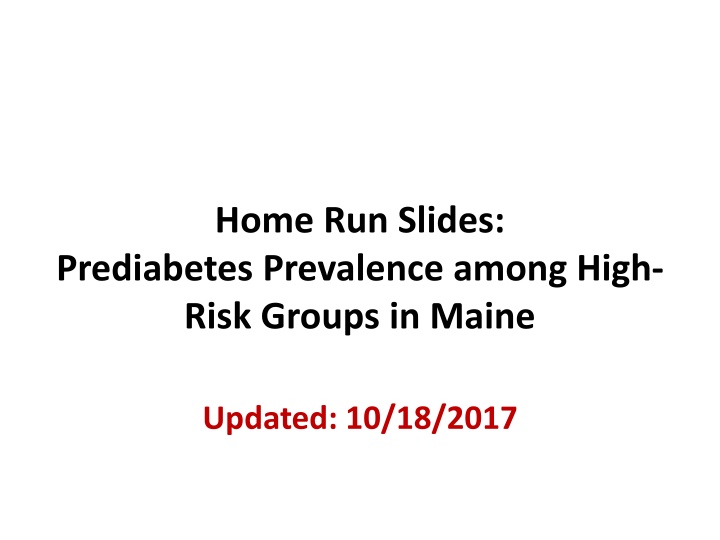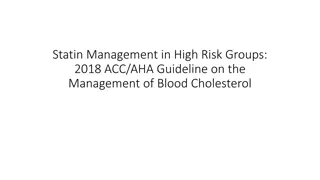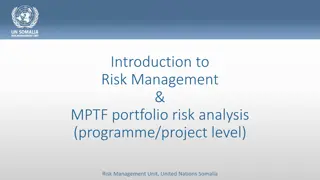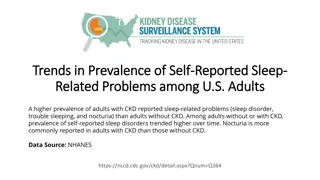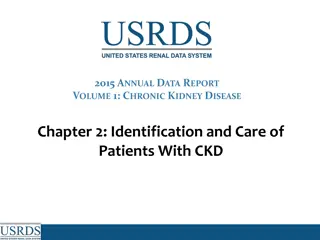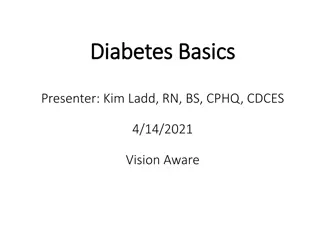Prediabetes Prevalence among High-Risk Groups in Maine
Among Maine adults, the prevalence of prediabetes and diabetes is explored, highlighting the risks associated with cardiovascular diseases. The data reveals concerning levels of undiagnosed diabetes and prediabetes, emphasizing the importance of early detection and management.
Download Presentation

Please find below an Image/Link to download the presentation.
The content on the website is provided AS IS for your information and personal use only. It may not be sold, licensed, or shared on other websites without obtaining consent from the author.If you encounter any issues during the download, it is possible that the publisher has removed the file from their server.
You are allowed to download the files provided on this website for personal or commercial use, subject to the condition that they are used lawfully. All files are the property of their respective owners.
The content on the website is provided AS IS for your information and personal use only. It may not be sold, licensed, or shared on other websites without obtaining consent from the author.
E N D
Presentation Transcript
Home Run Slides: Prediabetes Prevalence among High- Risk Groups in Maine Updated: 10/18/2017
Prevalence of Prediabetes and Diabetes in Maine Diabetes 10% Prediabetes 7% Non-diabetic or undiagnosed diabetes 83% Among Maine adults, 10% reported having been diagnosed with diabetes and 7% reported having been diagnosed with prediabetes. Though 83% of Mainers are non-diabetic, this percentage includes adults with undiagnosed diabetes or prediabetes. Source: U.S. Centers for Disease Control and Prevention, Behavioral Risk Factor Surveillance System (BRFSS), 2015.
Overweight or obese adults are the largest group at high risk for Type 2 diabetes at 66.5% of Maine adults.* High-Risk Groups for Type 2 Diabetes by Cardiovascular Disease Risk Factors and Outcomes Overweight or Obese 66.5 Physically Inactive** Risk Factors 46.1 High Cholesterol 38.5 High Blood Pressure 34.1 Racial/Ethnic Minority 5.2 Coronory Heart Disease 5.3 Outcomes Myocardial Infarction 5.5 Stroke 3.2 0 20 40 60 80 100 Prevalence (%) Source: U.S. Centers for Disease Control and Prevention (CDC), Behavioral Risk Factor Surveillance System (BRFSS), 2015. *Data based on self-report of selected risk factor or cardiovascular disease outcome on BRFSS. **Non-adherence to current CDC-recommended aerobic guidelines.
Undiagnosed Diabetes in the U.S Nationally, 30.3 million people (9.4% of U.S. population) have diabetes. Nearly a quarter (23.8%) of Americans with diabetes remain undiagnosed. The true diabetes prevalence among Maine adults could be close to 12.5%. We estimate that 101,400 Maine adults have diagnosed diabetes. If 23.8% of all Maine adults with diabetes are undiagnosed, then there are an estimated 31,700 Maine adults with undiagnosed diabetes. Source: U.S. CDC National Center for Chronic Disease Prevention and Health Promotion, Division of Diabetes Translation. National Diabetes Statistics Report, 2017. Available at: https://www.cdc.gov/diabetes/pdfs/data/statistics/national-diabetes-statistics-report.pdf
Prevalence of Diagnosed Prediabetes among High-Risk Groups for Type 2 Diabetes Prevalence of Diagnosed Prediabetes High-Risk Group % Heart Attack History 15.8 Coronary Heart Disease History 15.6 High Blood Pressure 12.8 High Cholesterol 12.3 Stroke History 11.4 Overweight or obese 10.2 Physically Inactive* 9.5 Racial/Ethnic Minority 5.7 Prevalence of diagnosed prediabetes is highest among Mainers with a prior cardiovascular disease diagnosis. Source: U.S. Centers for Disease Control and Prevention, Behavioral Risk Factor Surveillance System (BRFSS),Maine 2013 & 2014. *Data based on self-report of selected risk factor or cardiovascular disease outcome on BRFSS. All data from 2014, except for high cholesterol, high blood pressure, and physical inactivity which are from 2013. *Physical inactivity defined by CDC-recommended aerobic guidelines.
Diabetes Testing Guidelines The US Preventive Services Task Force (USPSTF) recommends screening for type 2 diabetes in asymptomatic adults aged 40 to 70 years who are overweight or obese. Clinicians should consider earlier screening in persons with 1 or more of the following: Family history of diabetes History of gestational diabetes or polycystic ovarian syndrome Members of certain racial/ethnic groups African Americans, American Indians or Alaskan Natives, Asian Americans, Hispanics or Latinos, or Native Hawaiians or Pacific Islanders Source: October 2015 https://www.uspreventiveservicestaskforce.org/Page/Document/UpdateSummaryFinal/screening-for- abnormal-blood-glucose-and-type-2-diabetes
Recent Diabetes Testing among High-Risk Groups Recent Diabetes Testing by High-Risk Group Recent diabetes testing by age group High-Risk Group % Adults 100 High Cholesterol 74.0 80 68.5 High Blood Pressure 73.9 66.2 Prevalence (%) 58.6 60 Heart Attack History 71.9 38.5 40 Coronary Heart Disease History 71.7 Stroke History 70.6 20 Overweight or obese 62.9 0 Physically Inactive** 56.1 Overall 18-39 years 40-70 years 70 years and over Racial/Ethnic Minority 49.5 Recent diabetes testing is lowest among overweight or obese, physically inactive, and racial/ethnic minority adults. Source: U.S. Centers for Disease Control and Prevention (CDC), Behavioral Risk Factor Surveillance System (BRFSS), Maine 2014 Recent diabetes testing is defined as having a diabetes test within the past three years. Data for physically inactive, high cholesterol, and high blood pressure was from 2013 BRFSS. *Data based on self-report of selected risk factor or cardiovascular disease outcome on BRFSS. **Non-adherence to current CDC-recommended aerobic guidelines.
Should We Target Overweight Young Adults for Diabetes Testing? For overweight or obese adults 40-70 years 18-39 years 100.0 P < 0.0001 Young adults are less likely than older adults to have: 80.0 70.7 Prevalence (%) 60.0 42.6 - Diagnosed prediabetes P < 0.0001 40.0 - Recent diabetes testing (within the past 3 years) 20.0 12.0 3.5 0.0 Diagnosed Prediabetes Recent diabetes testing Overweight or obese adults Source: U.S. Centers for Disease Control and Prevention (CDC), Behavioral Risk Factor Surveillance System (BRFSS), Maine 2014 *Data based on self-report of selected risk factor or cardiovascular disease outcome on BRFSS. Interpret with caution; based on an unweighted numerator(n) less than 50.
